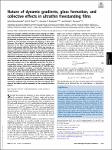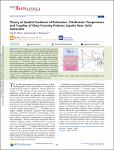Search
Author
- Kenneth S. Schweizer (2)
- Asieh Ghanekarade (1)
- David S. Simmons (1)
- Katsunori Wakabayashi (1)
- next >
Subject
- glibenclamide (1)
- indomethacin (1)
- Interfaces (1)
- Layers (1)
- < previous next >
Date issued
Search Results
Compression effects on alpha and beta relaxation process of amorphous drugs are theoretically investigated by developing the elastically collective nonlinear Langevin equation theory. We describe the structural relaxation as a coupling between local and nonlocal activated process. Meanwhile, the secondary beta process is mainly governed by the nearest-neighbor interactions of a molecule. This assumption implies the beta relaxation acts as a precursor of the alpha relaxation. When external pressure is applied, a small displacement of a molecule is additionally exerted by a pressure-induced mechanical work in the dynamic free energy, which quantifies interactions between a molecule with its nearest neighbors. The local dynamics has more restriction and it induces stronger effects of c... |
Nature of dynamic gradients, glass formation, and collective effects in ultrathin freestanding films Molecular, polymeric, colloidal, and other classes of liquids can exhibit very large, spatially heterogeneous alterations of their dynamics and glass transition temperature when confined to nanoscale domains. Considerable progress has been made in understanding the related problem of near-interface relaxation and diffusion in thick films. However, the origin of “nanoconfinement effects” on the glassy dynamics of thin films, where gradients from different interfaces interact and genuine collective finite size effects may emerge, remains a longstanding open question. Here, we combine molecular dynamics simulations, probing 5 decades of relaxation, and the Elastically Cooperative Nonlinear Langevin Equation (ECNLE) theory, addressing 14 decades in timescale, to establish a microscopic ... |
We employ a new force-level statistical mechanical theory to predict spatial gradients of the structural relaxation time and Tg of polymer liquids near microscopically rough and smooth hard surfaces and contrast the results with vapor interface systems. Repulsive rough (smooth) surfaces induce large slowing down (modest speeding up) of the relaxation time compared to the bulk. Nevertheless, a remarkable degree of universality of distinctive dynamical behaviors is predicted for different polymer chemistries and all interfaces, including a double exponential form of the alpha time gradient, power law decoupling of the relaxation time from its bulk value with exponential spatial variation of the exponent, exponential spatial gradient of Tg, weak dependence of normalized Tg gradients on... |





